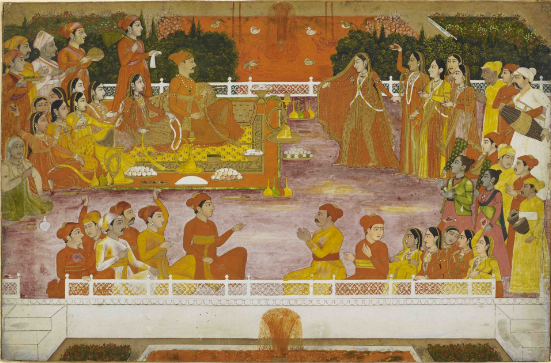Holi was celebrated as Id-e-Gulabi during the reign of Mughal emperors like Shahjahan and Akbar. In Mughal India, it was also called “Aab-e-Pashi” (shower of colourful flowers). It is mentioned in Tuzk-e-Jahangiri, the autobiography of Mughal Emperor Nuruddin Muhammad Jahangir, that Jahangir used to hold Mehfil-e-Holi.

A young nobleman enjoying Holi with his consort. Attributed to the artist Nidhamal, Lucknow, 1760-5. British Library, Add.Or.5700
Even though literature, art and music around Holi is mainly relegated to the Radha and Krishna lore, Holi and Islam have had a historic relationship in India which set the foundation of the Indian composite culture. Holi has been an integral part of Islam for centuries.
Holi was celebrated as Id-e-Gulabi during the reign of Mughal emperors like Shahjahan and Akbar. In Mughal India, it was also called “Aab-e-Pashi” (shower of colourful flowers). It is mentioned in Tuzk-e-Jahangiri, the autobiography of Mughal Emperor Nuruddin Muhammad Jahangir, that Jahangir used to hold Mehfil-e-Holi.
This syncretic culture in India was actually inspired by the holiest Sufi saint of Delhi, Hazrat Nizamuddin Aulia and his disciple, Amir Khusrow. They revered colours, especially “pink” and “yellow”, as divine expressions in their beautiful Persian and Hindavi poetry. Therefore, Holi and Basant became an integral part of the Dargah celebrations. Hazrat Amir Khusrow wrote beautiful poems on the divine connotations of colours in his Hindavi poetry:
Kheluungii Holi, Khaaja ghar aaye,
Dhan dhan bhaag hamare sajni,
Khaaja aaye aangan mere
(I shall play Holi as Khaaja has come home, blessed is my fortune, o friend, as Khaaja has come to my courtyard).
The famous Punjabi Sufi mystic — Bulleh Shah — rendered beautiful poetic exhortations of divine love and union in the celebration of Holi. His words are more relevant today in the conflict-ridden and communally-vitiated atmosphere:
Hori Khelungi, Keh Bismillah.
Nam Nabi ki ratn chadi, boond padi Allah Allah.
Rang rangeeli ohi khilave, Jis seekhi ho Fanaa fi Allah.
“Alastu bi rabbikum” Pritam bole, Sab sakhiyan ne ghunghat khole.
Qaloo Bala,yun hi kar bole, “la ilaha illallah”
(I will play Holi beginning in the name of the Lord, saying Bismillah.
Cast like a gem in the name of the Prophet,
Each drop falls with the beat of Allah, Allah,
Only He may play with these colourful dyes,
Who has learnt to lose himself in Allah.
“Am I not your lord?” asked the lover,
And all maids lifted their veils,
Everyone said, “Yes!” and repeated)
Jahangir used to hold Mehfil-e-Holi in `Tuzk-e-Jahangiri’. Many artists, specially Govardhan and Rasik, have shown Jahangir playing Holi with Noorjahan, his wife. Mohammed Shah Rangila would run around the palace, his wife chasing him with a ‘pichkari’.
The last Moghul Emperor, Bahadur Shah Zafar, allowed his Hindu ministers to smear his forehead with gulal on Holi. He believed that his religion would not be affected by this social ritual. “Jam-e-Jahanuma”, an Urdu daily, said in 1844 that during the days of the Mughal Emperor Bahadur Shah Zafar, special arrangements were made for Holi festivities.
Here’s what he wrote about the festival:
Kyun mope maari rang ki pichkaari
dekh kunwarji du’ngi gaari
(Why have you drench me with colour?
O Kunwarji I will swear at you)
bhaaj saku’n main kaise moso bhaajo nahin jaat
thaa’ndi ab dekhu’n main baako kaun jo sun mukh aat
(I can’t run, I am unable to run
I am now standing here and want to see who can dare to colour me)
Bahut dinan mein haath lage ho kaise jaane deoon
Aaj mainphagwa ta sau Kanha faita pakad kar leoon.
(After many days have I caught you, how can I let you go
I will catch you by your cummerbund and play Holi with you)
At Dewa Sharif, the Dargah of Haji Waris Ali Shah in Uttar Pradesh, Holi is celebrated with as much enthusiasm as Id. Munshi Zakaullah in his book “Tarikh-e-Hindustani” rightly asked: “Who says Holi is a Hindu festival?”
“Mir Taqi Mir, who was in the court of Nawab Asaf-ud-Daulah wrote in praise of Jashne-e-Holi. Wajid Ali Shah, the last Nawab of Awadh, who considered himself to be the embodiment of Krishna, is known to have celebrated the festival with much fervour. One time when Holi and Muharram fell on the same day, he made sure both festivals found attention at different times of the day. While the morning in Lucknow was marked by colours of Holi, the evening was sombre with mourning in place. Shah wrote, More kanha jo aaye palat ke, ab ke hori main khelungi dat ke. This thumri not only found a place in Vrindavan and Varanasi in the centuries that followed but found much resonance after thumri exponent Shobha Gurtu recorded it. Bollywood also immortalised it in Sardari Begum,” The Indian Express reported.
With Mughal art, music and literature celebrating the many colours of Holi, it seems reductive for any religion to stake a claim on any festival of joy. As many artists point out, the colours are smeared to remove any trace of identity and erase all differences, so that all of us can be one.
